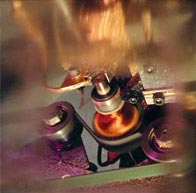| (insert your NIE or newspaper logo here) |
Weekly Online LessonOnline Lesson ArchiveGrade Level: 7-12
|
Digging Into Diamonds
 Humans have a long history of appreciating the special qualities of diamonds. Over the years and around the globe, their unique hardness, clarity and relative rarity have typically made them symbols of social and financial success. But, more recently, they have also become symbols of social and political conflict.
Humans have a long history of appreciating the special qualities of diamonds. Over the years and around the globe, their unique hardness, clarity and relative rarity have typically made them symbols of social and financial success. But, more recently, they have also become symbols of social and political conflict.
On Friday, April 25, 2003, President George W. Bush signed new legislation that tries to curb the illegal trade in what are referred to as "blood" diamonds. Such stones, also known as conflict diamonds, are thought to have financed violent civil conflicts in African countries including Angola, Sierra Leone and the Democratic Republic of the Congo.
 "Conflict diamonds have been used by rebel groups in Africa to finance their atrocities committed on civilian populations and their insurrections against internationally recognized governments," President Bush said.
"Conflict diamonds have been used by rebel groups in Africa to finance their atrocities committed on civilian populations and their insurrections against internationally recognized governments," President Bush said.
The new law, called, "The Clean Diamond Trade Act," provides the means for the United States to implement the Kimberley Process, a certification scheme which went into effect in January and aims to track each diamond from mine to shop window. The trade in blood diamonds is thought to comprise about 3% of the annual global diamond trade, said to be worth about $7 billion.
Americans buy billions of dollars worth of diamonds each year, about two-thirds of the world's supply. So in this week's lesson, you'll learn about the differences between gemstones and what makes diamonds so special.
Getting to Know Gemstones
 Begin your lesson at the PBS site, The Diamond Deception. Although the TV show is about how scientists are making synthetic diamonds, this website companion provides an overview of what makes diamonds special and how they compare with other types of gemstones.
Begin your lesson at the PBS site, The Diamond Deception. Although the TV show is about how scientists are making synthetic diamonds, this website companion provides an overview of what makes diamonds special and how they compare with other types of gemstones.
Start by reading The Science Behind the Sparkle. What happens to the speed of light when it travels through diamond? Why exactly does that happen? How do you think that causes diamonds to shine so brilliantly?
Next, compare the diamond with 19 other gemstones at this site's Gemstone Primer. First review the properties that experts use to determine the type and quality of a gemstone. What's the difference between a precious and semiprecious stone? What determines a gem's color? How do different stones vary in their chemistry and geometry? How is a gemstone's hardness determined? What does "specific gravity" mean?
 Now go check out the gallery's 20 different types of gemstones -- from Agate to Emerald to Moonstone to Sapphire to Zircon.
Now go check out the gallery's 20 different types of gemstones -- from Agate to Emerald to Moonstone to Sapphire to Zircon.
How are these gemstones different from each other, regarding their chemical composition, crystal structure, color, hardness, specific gravity and geographical origins? Do any of them share one or more similarities?
The Nature of Diamonds
Now that you've gotten an overview of gemstones, trek over to the American Museum of Natural History and dig deeper into The Nature of Diamonds.
 After reading the introduction, begin browsing the site at What is Diamond? In this section, you will learn more about diamond's properties, beginning with its composition. Move through the section by clicking NEXT at the bottom of each page. Here, you'll discover details about the gem's Structure, Durability, Density and Electrical Conduction.
After reading the introduction, begin browsing the site at What is Diamond? In this section, you will learn more about diamond's properties, beginning with its composition. Move through the section by clicking NEXT at the bottom of each page. Here, you'll discover details about the gem's Structure, Durability, Density and Electrical Conduction.
Why exactly is diamond so hard and durable? What are the relationships in temperature and pressure that make the difference between diamond and graphite? How is light refracted by diamond compared to air, water or glass? How well does diamond conduct eletricity and heat compared to other media? How might a diamond's purity affect its conduction of these energy types?
You now know more about what diamonds are, but where do they come from? To answer that question, check out the site's Origins section. After reading Where Does the Carbon Come From?, move through the pages to learn about their Formation, How Diamonds Surface, Where Diamonds Are Found and Indicator Minerals.
 How have geological processes created diamond deposits? Why and how are people able to find them? What is "kimberlite"?
How have geological processes created diamond deposits? Why and how are people able to find them? What is "kimberlite"?
Read through the rest of the section, from Kimberlite Pipes to Collisions and Star Dust. Why are different types of minerals and formations often found in an area together? What are the "new sources" of diamond?
Next, discover the world of diamond Mining & Distribution. Using the NEXT links, tour the world beginning Across Southern Africa, and running up through Russia and over to Australia then North America.
 Continue through the section by checking out the Types of Deposits, Mining a Kimberlite Pipe, all the way through Sorting and Distribution.
Continue through the section by checking out the Types of Deposits, Mining a Kimberlite Pipe, all the way through Sorting and Distribution.
How do you think mining and processing diamonds could affect local environments, particularly in countries with less stringent water and air quality standards than the U.S.? What positive or negative impacts might the diamond industry have on local economies or lifestyles? Why can't De Beers operate directly in the U.S.?
Lastly, browse through the Industry & Technology and Jewelry & Gems sections at the museum for a taste of how diamonds are used for practical and decorative purposes. In what different ways are diamonds used or fashioned? Is the same quality, or grade, of diamond used for both industrial and cosmetic devices? In your opinion, what are the merits of using diamonds in these or similar ways?
Newspaper Activities
In a current issue of Targetnewspaper, find articles or advertisements about diamonds or other gemstones. If you find an article, is the story about diamond trading or mining? Is the news centered around a particular location? Is it about legal or illegal activities? If you find an advertisement, is it for an industrial or decorative use of diamond or other gemstone? How does the ad portray the gem or product? How does the price or value of one piece of jewelry compare to another, particularly related to the type of gemstone or combination of gemstones used?
© Copyright 2002
Learners Online, Inc.
